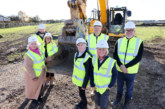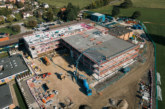
George Adams, Director of Energy and Engineering for SPIE UK, argues for holistic, whole system thinking during the design, construction and operational phases of buildings.
 Whole Life systems thinking is a comprehensive approach to support sustainable solutions. Asking the right questions for opening up sustainable thinking and establishing choices is critical as we move closer to a global warming tipping point. The chances for limiting global warming to 1.5˚C have almost disappeared; limiting it to 2.0˚C is also looking unlikely and so 3˚C or more seems the most likely journey we are on. Why? Because our trends of consumption and pollution is continuing to grow:
Whole Life systems thinking is a comprehensive approach to support sustainable solutions. Asking the right questions for opening up sustainable thinking and establishing choices is critical as we move closer to a global warming tipping point. The chances for limiting global warming to 1.5˚C have almost disappeared; limiting it to 2.0˚C is also looking unlikely and so 3˚C or more seems the most likely journey we are on. Why? Because our trends of consumption and pollution is continuing to grow:
- Today, we consume 50% more natural resources than the Earth can replace.
- By 2035 our GDP is likely to increase by 75%.
- By 2035 our energy consumption is likely to grow by 30%.
- By 2035, 80% of our energy is likely to come from fossil fuels.
However, we also need to understand the context of cities in this mix of environmental impacts:
- Cities currently consume about 75% of the natural resources we take out of the planet, however, cities only occupy about 50% of the population.
- The heat island effect created by cities is likely to be contributing to global warming.
The need for whole life thinking is clear; if we simply carry on our current and unsustainable behaviours, then climate change will pose a huge challenge. Yet it also presents a potential opportunity to galvanise cities and organisations into a new era of responsible decision-making. A critical part of this is how to make current urban spaces cleaner, greener, more efficient and aim towards a future of nett zero carbon balance. Why? Because cities contribute, in total, about 70% of damaging global emissions, and only 1 to 2% of our building stock is new-build each year. This creates a platform for adaption and resilience.
We need to take action to create urban communities capable of providing a decent existence for societies, business, housing organisations and the infrastructure that people depend upon. In the future, it is likely that 80% of the world’s growing population will live in cities; more densely populated; consuming more natural resources and creating more environmental damage.
Encouraging dynamic change
Buildings are a fundamental part of human society’s existence; clearly our whole life decision-making needs a thorough overhaul in the face of growing environmental degradation. There is potential for cities/urban areas and networks of sustainability-focused groups to work together to bring about this dynamic change.
Cities and their local authorities can be the driver for the change to whole life development. They are in the position of being a catalyst, supported by network communities of experts and contributors to the cause of creating whole life based, sustainable thinking and action. The key issues are many and at the core is likely to be:
- Asset value and life extension
- Health and wellbeing
- Efficiency and re-cycling
- Energy and net zero carbon balance
- Social and economic stability
- Eliminating pollution
- Global water and energy fairness
Adaptation and lifecycle improvement of our buildings requires collaboration at all levels and local authorities seem to be the best option for bringing together the skills, knowledge and vision of what needs to be done.
Our decision-making and the systems we create must be environmentally beneficial, socially sustainable and interoperable to create connected neighbourhoods that can develop a local, national and even global drive towards change for integrated whole life economics, and environmental protection. That is whole life thinking.








